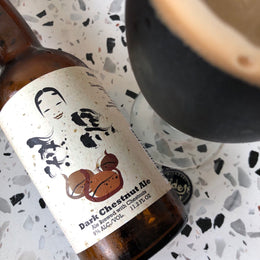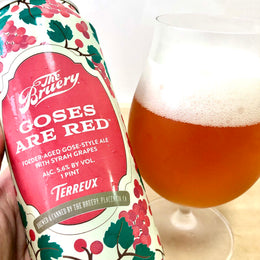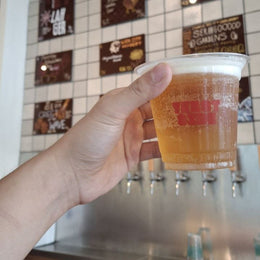We Taste Test Sierra Nevada's Big Hit "Little Thing"s: Hazy Little Thing, Wild Little Thing, Sunny Little Thing, Juicy Little Thing & Big Little Thing

Sierra Nevada's claim to fame is often said to be that of helping to re-popularise the IPA class of beers.
Now every beer lover worth their salt (and some undeniably worth less than) knows about the India Pale Ale category of beers, or IPA for short. Or at the very least they'd know it by name.
But let's start with a story.


The Mythical IPA
The name India Pale Ale comes from the 18th Century (or you might know it better as the 1750's) practice of British brewers fortifying their ales with more hops - those green conical flowers that give beers their bitterness - to make the journey intact all the way to India, in order to satisfy the thirsts of British soldiers stationed there.
See hops aren't just to give beers that bitter flavour to balance out the otherwise sweet malt; they also act as a preservative to help keep beers more shelf stable under the gruelling tropical climate. And so British brewers then would make their beers extra hoppy.

Hops for the road? (Image Source: The Brew Buddy)
And over time, it seemed as though the flavour profile took off. Folks took well to that green bitterness.
That's all well and good, except that's not true.
The story above is for the most part the de facto myth behind the creation of IPAs.
Records show that back then in the 1750's, not only were stouts and porters also shipped off to India just fine without the need for extra hops, but just a decade later, almost all beers were extra hopped.
Nonetheless, the term IPA first originated then, but later died down.
The Comeback Kid
It wasn't until the 1970's that a bunch of brewers started to revive the style of beers. Of course, Sierra Nevada wasn't alone in this endeavour, heck, they weren't even the first.
But what they did do was really bring it to the faces of beer lovers and shoved it right at them so that there was no denying the style.

Ken Grossman played a pretty big hand in re-popularising the IPA. (Image Source: UPROXX)
Sierra Nevada was founded in 1980 California by homebrewers Ken Grossman and Paul Camusi, with the intent of using whole-cone American hops for their pale ales; in particular a new varietal known as Cascade, which became famous for bringing intense grapefruit flavours to pale ales; that were said to be brighter, fruitier and more resinous than English hops.
At the time, this was considered to be an intensely hoppy beer, and so a name beyond pale ales was necessary for some delineation between the profiles - thus the IPA name was properly re-popularised.
Today, the hoppiness of the same beers are considered fairly normal, but only because our tolerance of hops has steadily increased over time.

A movement or a one hit wonder?
| Also Read: Sierra Nevada Pale Ale, 5.6% ABV – This Beer Started the US Craft Beer Revolution
Destined To Be A One-Trick Pony?
But what happens when you become so well-known for something that it's just impossible to see you any other way? Like Snow Patrol's 2006 hit single Chasing Cars, or Austin Butler's Oscar-nominated performance in the hit biopic Elvis (too soon to call time?).
Little did Sierra Nevada, which started out as an almost artisanal craft brewer, know that three decades later, it would be a behemoth known singularly for its West Coast-style IPA.
As increasing hoppiness levels became normalised, a new classification was again necessary - West Coast-style IPAs versus East Coast-style IPAs; the difference being that the West Coast style favours an intense bitterness from start to finish, while the East Coast style is sweeter at the start and finishes bitter.

The Sierra Nevada Brewery. (Image Source: ICPI)
Sierra Nevada was the poster child for West Coast-style IPAs.
Yet, as a large entity by the 2010's, there was a serious existential fear it faced - new trends, much like the one it rode to the height of its success, were emerging and yet it struggled to shrug off its still lucrative synonymity with the now well-understood West Coast-style IPA style.
Was it to watch the Hazy IPA trend sail by and potentially wash away the good work that Sierra Nevada had done?
A Little Thing, A Big Re-Invention
That's when the brewery had a real A-Ha moment - maybe if it created an offshoot brand, it could preserve its fame and existing fanbase, whilst being able to explore new trends with mitigated risk of being labelled a sell-out or a trend-chaser - thus the Little Thing brand was conceived.

You couldn't even tell them apart.
Little Thing allowed Sierra Nevada to open up the realm of possibilities that it would never be able to do so so long as it donned its signature hop-green label.
A whole new brand identity was created, with a slew of vibrant, almost candy-coloured labels, dotted with lots of fun-vibey bubbles - an almost psychedelic bubblepop style - basically the furthest thing from the traditional, outback/nature reserve/ranch-styled motif.
Instead of an intense all-roads-lead-to-Rome brand portfolio that wrapped around the single Sierra Nevada Pale Ale label, Little Thing would be more fun, more experimental, more encouraging of folks to step into this brave new IPA world through an intensely colourful party pack.

Little Thing went one way, whilst allowing Sierra Nevada to continue to head right in the opposite direction - simultaneously! The Torpedo was a heavily hopped West Coast IPA.
The first product under the new Little Things banner was the Hazy IPA, a fast growing style that sees traditional IPAs go unfiltered, brewed with hops added towards the end of the boil or even after, rather than at the start, use higher protein grain like oats and wheat, and finally undergo a secondary fermentation process.
Throw away all the mumbo-jumbo and what it really is, aside from its noticeably more cloudy appearance, is an IPA that is less bitter, creamier or more full-bodied and also somewhat fruitier.
And, boy, did this work like a charm. Few gambles have paid off as smoothly or as well as what Sierra Nevada did with Little Things. The Hazy IPA was a real hit, even smashing No. 4 on ranking of craft beer brands in 2021, ironically displacing Sierra Nevada's mainstay Pale Ale, which was now relegated to No. 5 on the craft beer ranking boards.
It's the sort of success you could only dream of.
If you really want to get into the details, it was such a blistering success that the Hazy Little Thing gambit actually brought a whole new class of consumers to Sierra Nevada. Rather than hardcore beer crushers, Hazy Little Thing had apparently brought in a whole new demographic of consumers stolen from the fast-growing Hard Seltzer category. Wow.

The Rulebook That Worked
This emboldened the brewery to take on more experimental styles, expanding the brand since its 2018 launch to include Wild Little Thing Sour Ale, Sunny Little Thing Citrus Wheat Ale, Big Little Thing Imperial IPA, Crisp Little Thing Easy Drinking Lager, as well as two additional Hazy IPA variants, Tropical Little Thing and Juicy Little Thing.
The idea here was to be an entry point or gateway for folks who weren't traditionally into IPAs to get their first steps in, really leaning into the whole idea that Sierra Nevada could actually tap into new customers outside the usual IPA crowd.
So today, we've managed to get our hands on four Little Thing labels - the Hazy Little Thing IPA, Wild Little Thing Slightly Sour Ale, Sunny Little Thing Citrus Wheat Ale & Juicy Little Thing Hazy IPA.
Let's go!
PS. It's kind of cute that at the top of each can it says "Family Owned, Operated & Argued Over". My family just argues and owns nothing. 🤷♂️
Sierra Nevada Hazy Little Thing IPA 6.7% ABV - Review

Let's start with the one that kicked it all off - the Hazy Little Thing IPA.
As mentioned earlier, the Hazy IPA was a style that was becoming quite popular in the craft beer space, and was one that Sierra Nevada had wanted to experiment with but nonetheless felt bounded to its claim-to-fame Pale Ale.
Hence the Little Thing offshoot was created to hold Sierra Nevada's interpretation of the Hazy IPA.
As with the Hazy IPA recipe called for, this was dry-hopped and not filtered as much to keep that cloudiness. It was made with a combination of Munich malt, Two-row Pale malt, oat and wheat (malted and unmalted), and a slew of hops including Citra, El Dorado, Magnum, Mosaic and Simcoe (basically the who's who of IPA hops) was applied. Finally, ale yeast was used for the fermentation.

Tasting Notes
Color: Gold
Aroma: Lots of grapefruit notes – the acidity and bitterness. A light sourness from the foaminess. Very classic IPA.
Taste: This one’s alittle more hefty and creamy, with soft notes of grapefruit that’s quite well integrated into the thicker body, with more on those grapefruit pith.
Finish: Lingering notes of those grapefruit bitterness and alittle more maltiness that gives it a touch of butteriness to balance out the acidity.

My Thoughts
My Rating: 🥱
The texture here was thicker and mostly embodied the classic IPA grapefruit notes from aromas to finish. It’s pretty singular and one dimensional and quite soft overall, with not much to write home about. A plus point would be that the taste on the palate was pretty well integrated, but that’s about it.
Not particularly inspiring.
Sierra Nevada Wild Little Thing Slightly Sour Ale, 5.5% ABV - Review

We're off to the next one - the Wild Little Thing Slightly Sour Ale.
As with Sours, this used kettle souring to create more lactic acid - which is what creates that sourness and tartness. It's alittle like the way yogurt is made.
A combination of malts including Two-row Pale, oats and wheat was used, and here the singular Cascade hops that Sierra Nevada popularised is applied. Ale yeast used here as well, with guava, hibiscus and strawberries added to the mix as well.

Tasting Notes
Color: Copper
Aroma: Light tart cherry notes, with notes of cherry twizzler candy or cherry-flavoured licorice. More acidity from those green apple aromas, unripe red dragon fruit, it’s also alittle citrusy of grapefruit, with notes of hawthorn and cranberries – a really tart bunch of red fruits. Lots of acidity and sourness.
Taste: More mellow, much more mellow in fact. Not nearly as tart as its aromas – gentler notes of hawthorn, cranberries and cherries. There’s a sort of isotonic taste about it as well, and also more on barley sugars and wheat. Light notes of grapefruit pith.
Finish: Pretty clean with lingering notes of cherry-flavoured isotonic.

My Thoughts
My Rating: 🤪
It really did feel kinda wild actually – at least on the aromas there were lots of wild tart red fruits or unripe berries and orchard fruits. It was really expressive on the aromas, but on the palate it was a lot gentler, which is a saving grace if you’re not a fan of sour things. Nonetheless the flavours on the palate was quite muted and alittle bit of a let down quite frankly.
Overall, a fairly aromatic but lightly flavoured beer. Did give off some wild vibes nonetheless.
Sierra Nevada Sunny Little Thing Citrus Wheat Ale 5% ABV - Review

Third one in - the Sunny Little Thing Citrus Wheat Ale.
This uses Carapils, Two-row Pale, oats and wheat for malts, and then Crystal hops were applied, along with ale yeast.
Here the idea was to pull back on the really austere hoppyness and let the fruitiness come through more.

Tasting Notes
Color: Red Bull Energy Drink
Aroma: Super bright aromas of orange candy and Sunkist orange drink. There’s a light wheatiness to it as well, with more on those grain sugars. Very aromatic and actually alittle reminiscent of energy drinks.
Taste: It starts off with cooked barley, leading into a soft note of diluted orange cordial that is slightly sour albeit bright, and then more onto orange pith.
Finish: It’s more malty here with butter cookies, wheat and a light pop of Orangina drink.

My Thoughts
My Rating: 😅
The aromas were quite interesting given how bright they were and citrusy, but on the palate it was a lot less coherent and was alittle too soft for my liking with not that much flavour or body, and not all that distinctive either. It was like a lite continuation of the aromas and was alittle watery. The finish did make up for it alittle bit but overall, kind of expected more.
Sierra Nevada Juicy Little Thing Hazy IPA - Review

This last one (of the session) is a limited time Hazy IPA variant, and is only available in the first quart of the year.
Here Two-row Pale, oats and wheat were used for malts, and also a mix of Citra, El Dorado, Mosaic and Sterling (a more specialised varietal) hops, finally ale yeast was applied.
This experiment was created to allow the Sterling hops to accentuate those fruity guava, mango and grapefruit notes.

Tasting Notes
Color: Pineapple Juice
Aroma: A waft of pomelo, mango, pineapple; slightly fermented notes. Kind of reminiscent of a pineapple tepache. There’s a little bit of more of citrus, with an aromatic richness. Slightly lactic, but still somewhat fruity and sweet.
Taste: More on those classic IPA notes of pineapple, as well as pineapple tart filling – slightly concentrated but still with that sourness. There’s a greenness from the hops as well.
Finish: The hoppy bitterness comes through more here, leaving a light bit of stewed pineapple and more on those sour fermented pineapple tepache notes.

My Thoughts
My Rating: 🙄
More body here as well, but once again, a pretty classic IPA profile, but here alittle darker and more concentrated, with more accentuated notes of tropical fruits, and with the often associated sourness. The hops is also alittle more apparent here with that green bitterness.
Again, nothing much to stoke anyone’s envy here.
Sierra Nevada Big Little Thing Imperial IPA - Review

This Imperial IPA - basically a stronge, darker, more dank IPA - is made with Munich, Two-row Pale and Wheat malts, and a heavy combination of Cascade, Chinook, Columbus, Crystal, Idaho 7, Magnum and Mosaic hops - say what!
Ale Yeast too. The grain is mashed lots to yield a higher ratio of fermentable versus unfermentable sugars as per Sierra Nevada - that gets the yeast to digest most of the sugars. Obviously dry hopped as well!

Tasting Notes
Color: Deep Gold
Aroma: Light honeyed notes with light sweet sour pineapples and oranges, and a light hoppy grassiness. A nice aroma of cereals and oats too.
Taste: Full-bodied that starts off lightly sweet of syrup that then goes into a juicy vegetal, grassy bit of pineapples and hops - it’s bitter but not overwhelmingly so. The candied maltose flavors still take the fore with a sort of candied sourness that’s reminiscent of candied ume fruit.
Finish: Clean, crisp with more on honey and beeswax, leaving a light honeyed sweetness.

My Thoughts
My Rating: 😈
This was the best of the Little Things series in my opinion! A really good malty heftiness and a gentle vegetal hoppiness that isn’t overpowering - that’s all of the flavours but still very much drinkable and accessible without getting too fierce.
I really enjoyed that this seemed to be the more flavour packed of the lot but yet managed to stay really accessible and drinkable. The hefty, malty body was definitely a step up!
The best of the lot so far!
Overall
Having tried five out of the full range of Little Thing (which has 7 labels in total), of which three of them form the year-round core range, I'm getting some sense of its style - and quite honestly it's really as its name suggests - little things.
It's pretty clear that with the Little Thing range, Sierra Nevada has significantly pulled the throttle on its full expression (which we can clearly contrast with the classic Pale Ale, which by the way is a totally awesome IPA). These are definitely hosed down to make the whole IPA style much more palatable to newcomers or those taking their first steps into the IPA scene - which the brewery hopes to drawn in.
And it works - after all Little Thing is doing really well, so there's certainly a sizeable audience that enjoys it, which I can certainly see given everything from the funky, fun-looking packaging, to the whole idea of getting a variety pack and trying a bunch of different styles. It's precisely catered to new beer drinkers.
Nonetheless, if you're a seasoned drinker, you're almost certainly going to find this too soft for your liking. It's kind of like going from a sports car to a saloon vehicle - it's not the saloon vehicle's fault it's not designed to go at some tear-your-face-off speed.
For folks new to craft IPAs, this is a decent place to start, but for the seasoned drinkers, perhaps the Wild Little Thing and Big Little Thing might tickle your fancy.
And while we're at it, if Sierra Nevada is ever reading this, I do think you can take it up at least two notches up on the Little Things.
Big, big fan of the classic Pale Ale.
Kanpai!

@111hotpot







